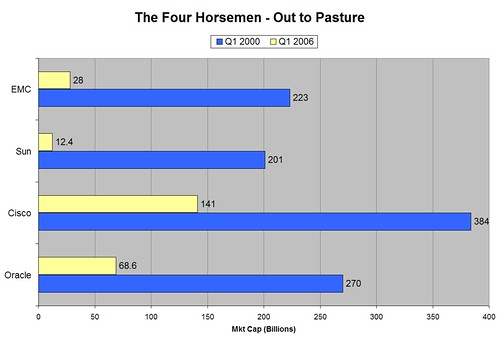 Intel corp (INTC) lands on Page A1 of the WSJ with a story covering their Analyst Day presentation in New York yesterday. The big news that is getting widespread coverage in many media outlets- including BusinessWeek - is that they are cutting $1BB (8%) in spending but without across the board job cuts.
Intel corp (INTC) lands on Page A1 of the WSJ with a story covering their Analyst Day presentation in New York yesterday. The big news that is getting widespread coverage in many media outlets- including BusinessWeek - is that they are cutting $1BB (8%) in spending but without across the board job cuts.
The big problem is Intel’s work force grew 17% in the last year alone. So, the obvious path is to find businesses with high costs and low revenue, and spin those out to people who can manage them tighter. It sounds like this is exactly what Intel plans to do.
From the article:
Mr. Otellini promised to look at “anything with a bracket on it” — a reference to the practice of putting parentheses around numbers in income statements to indicate a loss. In the first quarter, that category included a unit that makes chips known as flash memory, which are used to store data in portable gadgets such as cellphones. That business, which is subject to stiff price competition, had an operating loss that widened to $104 million from $32 million in the year-earlier period.
How exactly is it that you couldn’t make money in flash over the last few years you ask? Until very recently Intel built only NOR flash, rather than the NAND flash that has buyers in a global-crisscrossing frenzy trying to secure supply. Check the wiki for a good overview of the differences. NOR flash isn’t as hot as NAND these days as it lacks the ‘iPod cachet’ (the iPod and other flash based memory players use NAND).
I’m not an expert on the ins and outs of the flash business, but I do know the worst time to sell a business is when no one wants it. Why can’t Intel clean this up themselves? Anyone care to comment?
The communication semiconductor, wireless, and optical business at Intel is another story altogether. Virtually an entire standalone company stretching from Network Processors to Storage to SONET/SDH chipsets to optical modules exists within Intel. Other than the large market share Intel enjoys with it’s 10GbE modules at Cisco the most remarkable thing about this division has been it’s ability to bleed cash.
Up until January of 2004, when Intel decided to merge the groups (and make the accounting more opaque), the wireless and communication groups were losing nearly $1BB a year. They are now shrouded in a massive group called ‘Mobility’, co-run by Sean Maloney, who oversaw the radical expansion and subsequent poor performance of these businesses during the boom. It isn’t clear where things stand financially now, but a qualitative estimate (i.e. wild-ass-guess) on my part would say the business is still losing 300M-500M annually. Witness the large amounts of money being poured into WiMax, PCI-Express/Advanced Switching. It is safe to assume thriftiness has not taken hold.
The Intel communication business is a case study in waiting for a private equity takeover and turnaround. KKR and Silver Lake Partners acquired Agilent’s semiconductor business with this intention. I imagine they will be interested, among others. Given the lack of good data on individual business unit size and performance it’s hard to put a price tag on what the business is worth. It is safe to say that it would be a big liquidity event for Intel, and allow the company to focus on it’s core businesses - memory and processors.
The possibilities for positive consolidation with portions of Intel’s comm semi business are limitless, which is why it’s such an attractive deal. Finisar (FNSR), JDSU (JDSU), Bookham (BKHM), PMC-Sierra (PMCS), Broadcom (BRCM), AMCC (AMCC), Marvell (MRVL) and many others would all be interested in portions of Intel’s comm and optical business. The more interesting and risky alternative is to keep the business whole, scrub it down hard, and spin in companies that have failed to gain critical mass following the communication implosion of 2001. This would take a great deal of cash and credit, something the market may be on the verge of granting in these days of private-equity gone wild.
It will be interesting to see if Intel attempts to sell off small pieces; i.e. NPU’s here, SONET/SDH there, optical modules here and there. Or, will they unload the giant mass into the hands of a private equity firm that will handle the slaughterhouse task of filleting the fine meat and grinding up the bone for cattle feed. My guess is the latter.
This is just about the best consolidation opportunity in the comm semi business I’ve seen.
Update 4 May 2006: Lightreading just published an article on the same subject.




Recent Comments
chuck goolsbee, Tony Blur
solid gold suleyman
Bill Baker, Andrew Schmitt, DG Lewis, Andrew Schmitt, Jim W [...]
Andrew Schmitt, Francis, Bruce, Ed Draker, Cooters
Andrew Schmitt, Bandgap, Ed Draker, John Badger
Bandgap
Bubblebobble
cdt2001, Cooters, Andrew Schmitt, Cooters, PakBrain [...]
Frank C., Niles